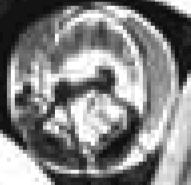| Review: The Complete Cartoons of The New Yorker (2004) Edited by Robert Mankoff and David Remnick. 656 pages, 2 CDs | |
How big is it?When I heard that the complete set of New Yorker cartoons would be published, I was hoping for an encylopedia, big volumes printed on very thin paper that would allow me to pull out So-Te and find cartoons about Starfish and Tarragon.Well, it's not that. It's a big, heavy book, though. You need both hands to lift it. It is on the market in time for use as a Christmas gift, but if, like me, you travel to see your family around that time, you should have it shipped separately, because you don't want to lug this thing to the airport. It's no use as a coffee table book, because you'll want to get pretty close to see the details and read the small print; and it's a bit too heavy to balance on your lap. After stubbing my thumb moving it around, I've settled for just having it lie flat on the floor. In spite of its heft, the book only reprints a small portion of the cartoons ever printed. (I'm told they're 2004, I haven't counted them out.) The complete set is only on the CD-ROMs, about which more in a moment. In the book, the reprinted cartoons are ordered by year and grouped by decade. Each decade has an introductory article; there are some about specific subjects. If the cartoons small, there are four of them on the page; usually, it's two or three. It's almost a bit crowded; cartoons that don't fill a a box well have other cartoons intrude on their space, the way (perhaps) text flowed around them originally. But what works for text doesn't always work for drawings, and sometimes the cartoons blend together and tell stories they weren't intended to tell. (The CD ROM doesn't do that; there, each picture has its own page.) How well did the old ones age?The time does make a difference. Some of depression-era humor no longer works. I'm not sure whether that's because the themes have changed or whether the way humor is constructed has changed; or maybe the editors deliberately picked jokes that illustrated themes of the time more than just delivered punchlines, not a bad idea.Let's look a random pair of pages from 1926.
Compare those to a random pair of pages from 2001:
Still, they're are just as contextual as the ones from 1926, it's just that the movies and cliches they refer to are mine, and they don't give me any trouble. (Oh well, "Duh.")
For the depression-era cartoons that do give me trouble, it
would have been great to have captions that explain why this is
funny. Maybe someone will; it would be a good companion site to set up. After 1939 or so, the cartoons become a lot easier to understand; partially because the world today isn't that different from the world in the 50ies, partially because the concerns of World War II are better known to me than the depression-era atmosphere. The CD-ROMThere's a two-disk CD ROM that comes with the book. The two disks are embedded in the stiff front cover and don't get in the way, but it's hard to extract them from their plastic sleeves; I tore off some of mine in the attempt. The cartoons are reproduced as PDF files. Unlike the book, this really is the complete archive of every single New Yorker cartoon ever printed.The PDF file has been marked as printable, but can't have images extracted from it. Unless you know how to take screenshots, I guess. The archive is searchable, but grouped by time; if you want to search everything, you'll have to search once for each disk. Each cartoon has been annotated with keywords; those are what gets searched. You can kind of see the keywords in the browser. So, let's take the one where the mechanic pops the hood of a car and says "May I ask who's been doing your repair work?" at the sight of a wheel with a squirrel in it.Apart from its punchline, it will also match searches for any of automobiles autos bird cage cages car cars dog drive driving fish fix motor owner pet pets puppy rodent rodents shop squirrel squirrels wheel wheels 146024 Charles Addams (12/10/1938) Compiling that index must have been a lot of work, even given its obvious shortcomings (the picture contains no bird, dog, or fish.)Even though I'm not sure those are squirrels. Zooming in doesn't help; the image breaks up into large pixels fairly soon. This doesn't get in the way of just reading the cartoons, but those are images scanned with barely enough resolution to print well at the original size; they won't withstand magnification.  Adobe Acrobat view, 400% magnification. Squirrel, dog, bird, or fish? In my version of Adobe Acrobat, text is searched for as substrings of the per-image keyword data in the index. So, when searching for multiple keywords, the keywords have to be adjacent in the description (which is alphabetically sorted). In case of our squirrel cartoon, searching for "shop squirrel" will find it, but "squirrel shop" won't. Unless a phrase is directly part of the subtitle, searching for more than one word is pretty hopeless. Still, the sheer volume of the material involved is impressive. The interface is completely geared towards using the data off the CD, without copying or installing anything except perhaps the Adobe Acrobat reader. But ultimately, this is just a directory full of PDFs, so copying them to a local disk isn't a big deal. Takes about 1.3 gigabytes. And now excuse me, I have 1140 Roz Chast cartoons to catch up on. Jutta Degener, Nov 2004, for quut.com
|